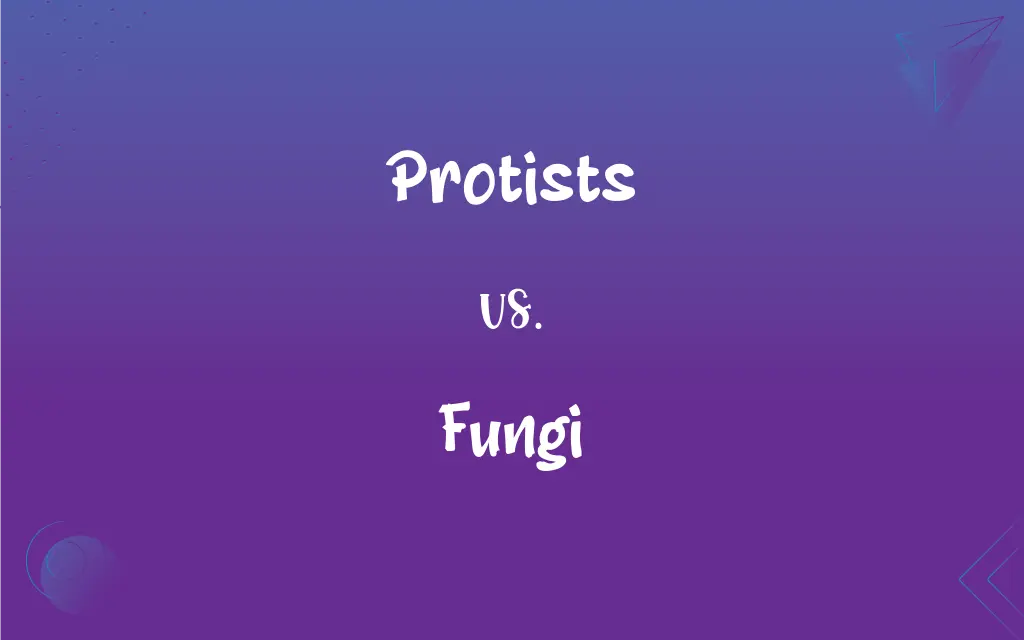Protists vs. Fungi: What's the Difference?
Edited by Aimie Carlson || By Harlon Moss || Updated on October 19, 2023
Protists are diverse single-celled eukaryotic organisms; fungi are multicellular eukaryotes that decompose organic matter.

Key Differences
Protists are a diverse group of single-celled eukaryotic organisms that can be found in various habitats, including freshwater, saltwater, and moist terrestrial environments. In contrast, fungi are primarily multicellular eukaryotes, although there are some unicellular fungi known as yeasts.
Protists encompass a wide range of organisms, from algae to protozoa, and can be autotrophic (photosynthetic) or heterotrophic. Fungi, on the other hand, are heterotrophic and obtain their nutrients through absorption, often decomposing dead organic material or forming mutualistic relationships with plants.
While protists reproduce mainly through binary fission, some also engage in sexual reproduction. Fungi reproduce both sexually and asexually, with the latter involving the production of spores.
In terms of cellular structure, protists generally lack the complex tissue differentiation seen in higher organisms. Fungi exhibit more complexity, with many forming intricate networks called mycelium made up of thread-like structures known as hyphae.
Both protists and fungi play vital roles in ecological systems. While protists are crucial in aquatic food chains and contribute to nutrient cycling, fungi help break down organic matter, returning essential nutrients to the soil.
ADVERTISEMENT
Comparison Chart
Basic Description
Diverse single-celled eukaryotic organisms
Multicellular eukaryotes that decompose organic matter
Nutrient Acquisition
Autotrophic or heterotrophic
Heterotrophic through absorption
Reproduction
Mainly binary fission; some sexual
Both sexual and asexual (often through spores)
Cellular Complexity
Generally lack tissue differentiation
Mycelium made of hyphae; more complex structures
Ecological Role
Important in aquatic food chains
Decomposition and mutualistic relationships
ADVERTISEMENT
Protists and Fungi Definitions
Protists
Eukaryotic organisms that are not animals, plants, or fungi.
Many protists are microscopic and live in aquatic environments.
Fungi
Organisms with a cell wall made of chitin.
Unlike plants, fungi do not produce their food through photosynthesis.
Protists
Diverse group encompassing algae and protozoa.
Some protists, like amoebas, move using pseudopodia.
Fungi
Symbiotic or parasitic organisms with complex life cycles.
Many plants form mutualistic relationships with fungi to enhance nutrient absorption.
Protists
Single-celled life forms with complex cellular structures.
The study of protists provides insights into the early evolution of eukaryotes.
Fungi
Eukaryotic decomposers that absorb nutrients.
Mushrooms, a type of fungi, are popular in many culinary dishes.
Protists
Organisms with a nucleus enclosed within membranes.
Protists can reproduce asexually through binary fission.
Fungi
Spore-producing organisms.
Some fungi release spores that can be allergenic when inhaled.
Protists
Microorganisms distinct from bacteria, fungi, plants, and animals.
The pond water sample revealed a variety of colorful protists under the microscope.
Fungi
Includes yeasts, molds, and mushrooms.
Bread mold is a common type of fungi that grows on stale bread.
Protists
Any of numerous eukaryotic organisms that are not fungi, plants, or animals and are chiefly unicellular or colonial. Protists that are multicellular do not have cells differentiated into tissues. The protists include the protozoans, certain algae, oomycetes, and slime molds.
Fungi
A plural of fungus.
Protists
Plural of protist
FAQs
Are all protists harmful?
No, while some protists can cause diseases, many are harmless or even beneficial, similar to fungi which can be both beneficial and harmful.
Are fungi plants?
No, fungi are a separate kingdom from plants, animals, and protists.
What's a common example of protists?
Amoebas and paramecia are common protists, while mushrooms are common examples of fungi.
Do fungi have chlorophyll?
No, fungi lack chlorophyll, unlike photosynthetic protists.
What are protists?
Protists are diverse single-celled eukaryotic organisms that are not classified as plants, animals, or fungi.
Where can protists be found?
Protists can be found in various environments, including freshwater, saltwater, and moist terrestrial areas, unlike fungi which thrive in decaying organic matter.
Can fungi photosynthesize?
No, fungi cannot photosynthesize, unlike some protists like algae.
How do protists move?
Many protists move using structures like cilia, flagella, or pseudopodia, while fungi do not have locomotion.
Can fungi cause diseases?
Yes, some fungi can cause diseases in plants, animals, and humans, similar to certain pathogenic protists.
How diverse are protists?
Protists represent a highly diverse group, encompassing organisms from algae to protozoa, while fungi mainly consist of molds, yeasts, and mushrooms.
Are all protists single-celled?
While most protists are single-celled, there are some multicellular forms, whereas fungi are mainly multicellular.
What's the cell wall of fungi made of?
The cell wall of fungi is made of chitin, while protists generally have varying cell wall compositions.
What role do protists play in the ecosystem?
Protists play roles in nutrient cycling and form the base of many aquatic food chains, while fungi decompose organic matter.
Are mushrooms fungi?
Yes, mushrooms are a type of fungi, and they differ greatly from protists in structure and function.
Are fungi important for agriculture?
Yes, fungi play crucial roles in soil health and plant growth, while some protists can also be beneficial or harmful to agriculture.
Can protists be seen with the naked eye?
While many protists are microscopic, some, like certain algae, can be seen without magnification, unlike many fungi which are often visible.
How do fungi obtain nutrients?
Fungi obtain nutrients by absorbing decomposed organic material, unlike many protists that can produce their food.
How do fungi reproduce?
Fungi reproduce both sexually and asexually, often via spores, while protists mainly reproduce through binary fission.
Are yeasts fungi?
Yes, yeasts are unicellular fungi, contrasting with most protists which are also unicellular but belong to a different kingdom.
How do protists reproduce?
Most protists reproduce asexually through binary fission, although some engage in sexual reproduction, whereas fungi have diverse reproductive methods.
About Author
Written by
Harlon MossHarlon is a seasoned quality moderator and accomplished content writer for Difference Wiki. An alumnus of the prestigious University of California, he earned his degree in Computer Science. Leveraging his academic background, Harlon brings a meticulous and informed perspective to his work, ensuring content accuracy and excellence.
Edited by
Aimie CarlsonAimie Carlson, holding a master's degree in English literature, is a fervent English language enthusiast. She lends her writing talents to Difference Wiki, a prominent website that specializes in comparisons, offering readers insightful analyses that both captivate and inform.
































































